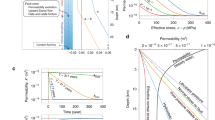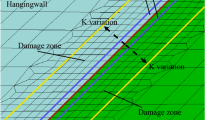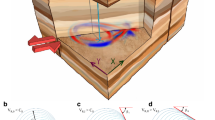Abstract
Spatio-temporal variation of rupture activity is modeled assuming fluid migration in a narrow porous fault zone formed along a vertical strike-slip fault in a semi-infinite elastic medium. Pores are assumed to be created in the fault zone by fault slip. The effective stress principle coupled to the Coulomb failure criterion introduces mechanical coupling between fault slip and pore fluid. The fluid is assumed to flow out of a localized high-pressure fluid compartment in the fault with the onset of earthquake rupture. The duration of the earthquake sequence is assumed to be considerably shorter than the recurrence period of characteristic events on the fault. The rupture process is shown to be significantly dependent on the rate of pore creation. If the rate is large enough, a foreshock–mainshock sequence is never observed. When an inhomogeneity is introduced in the spatial distribution of permeability, high complexity is observed in the spatio-temporal variation of rupture activity. For example, frequency-magnitude statistics of intermediate-size events are shown to obey the Gutenberg–Richter relation. Rupture sequences with features of earthquake swarms can be simulated when the rate of pore creation is relatively large. Such sequences generally start and end gradually with no single event dominating in the sequence. In addition, the b values are shown to be unusually large. These are consistent with seismological observations on earthquake swarms.
Access this chapter
Tax calculation will be finalised at checkout
Purchases are for personal use only
Preview
Unable to display preview. Download preview PDF.
Similar content being viewed by others
References
Bak, P., and Tang, C. (1989), Earthquakes as a Self-organized Critical Phenomenon, J. Geophys. Res. 94, 15,635–15,637.
Blanpied, M. L., Lockner, D. A., and Byerlee, J. D. (1992), An Earthquake Mechanism Based on Rapid Sealing of Faults, Nature 358, 574–576.
Brace, W. F. (1977), Permeability from Resistivity and Pore Shape, J. Geophys. Res. 82, 3343–3349.
Brace, W. F. (1980), Permeability of Crystalline and Argillaceous Rocks, Int. J. Rock Mech. Min. Sci. and Geomech. Abstr. 17, 241–251.
Brace, W. F. (1984), Permeability of Crystalline Rocks: New in situ Measurements, J. Geophys. Res. 89, 4327–4330.
Byerlee, W. F. (1993), Model for Episodic Flow of High-pressure Water in Fault Zones before Earthquakes, Geology 21, 303–306.
Chester, F. M., Evans, J. P., and Biegel, R. L. (1993), Internal Structure and Weakening Mechanisms of the San Andreas Fault, J. Geophys. Res. 98, 771–786.
Das, S., and Aki, K. (1977), Fault Plane with Barriers: A Versatile Earthquake Model, J. Geophys. Res. 82, 5658–5670.
David, C., Wong, T.-F., Zhu, W., and Zhang, J. (1994), Laboratory Measurement of Compaction-induced Permeability Change in Porous Rocks: Implications for the Generation and Maintenance of Pore Pressure Excess in the Crust, Pure appl. geophys. 143, 425–456.
Davison, C. C., and Kozak, E. T. (1988), Hydrogeological Characteristics of Major Fracture Zones in a Large Granite Batholith of the Canadian Shield, Proc. 4th Can./Am. Conf. Hydrogeol., 52–60.
Engelder, J. T. (1974), Cataclasis and the Generation of Fault Gouge, Geol. Soc. Amer. Bull. 85,1515–1522.
Evans, J. P. (1990), Thickness-displacement Relationships for Fault Zones, J. Struct. Geol. 12, 1061–1065.
Forster, C. B., Goddard, J. V., and Evans, J. P., Permeability structure of a thrust fault. In The Mechanical Involvement of Fluids in Faulting (eds. Hickman, S., Bruhn, R. L., and Sibson, R.) USGS Open File Report 94–228, pp. 216–223 (U.S. Geological Survey, Menlo Park, Calif. 1994).
Gold, T., and Soter, S. (1985), Fluid Ascent through the Solid Lithosphere and its Relation to Earthquakes, Pure appl. geophys. 122, 492–530.
Henderson, J. R., and Maillot, B. (1997), The Influence of Fluid Flow in Fault Zones on Patterns of Seismicity: A Numerical Investigation, J. Geophys. Res. 102, 2915–2924.
Hull, J. (1988), Thickness-displacement Relationship for Deformation Zones, J. Struct. Geol. 10, 431–435.
Marone, C., Raleigh, C. B., and Scholz, C. H. (1990), Frictional Behavior and Constitutive Modeling of Simulated Fault Gouge, J. Geophys. Res. 95, 7007–7025.
Miller, S. A., Nur, A., and Olgaard, D. L. (1996), Earthquakes as a Coupled Shear Stress High Pore Pressure Dynamical System, Geophys. Res. Lett. 23, 197–200.
Miyamura, S. (1962), Seismicity and Geotectonics, Zisin, Ser. 2, 15, 23–52 (in Japanese).
Mogi, K. (1963), Some Discussions of Aftershocks, Foreshocks and Earthquake Swarms, Bull. Earthq. Res. Inst. 41, 615–658.
Morrow, C. A., and Byerlee, J. D. (1989), Experimental Studies of Compaction and Dilatancy during Frictional Sliding on Faults Containing Gouge, J. Struct. Geology 11, 815–825.
Ohtake, M. (1976), A Review of the Matsushiro Earthquake Swarm, Kagaku 46, 306–313 (in Japanese).
Okada, Y. (1992), Internal Deformation due to Shear and Tensile Faults in a Half-space, Bull. Seismol. Soc. Am. 82, 1018–1040.
Raleigh, C. B., Healy, J. H., and Bredehoeft, J. D. (1976), An Experiment in Earthquake Control at Rangely, Colorado, Science 191, 1230–1237.
Rice, J. R. (1993), Spatio-temporal Complexity of Slip on a Fault, J. Geophys. Res. 98, 9885–9907.
Sammonds, P. R., Meredith, P. G., and Main, L. G. (1992), Role of Pore Fluids in the Generation of Seismic Precursors to Shear Fracture, Nature 359, 228–230.
Segall, P., and Rice, J. R. (1995), Dilatancy, Compaction, and Slip Instability of a Fluid-infiltrated Fault, J. Geophys. Res. 100, 22,155–22,171.
Sibson, R. H. (1974), Frictional Constraints on Thrust, Wrench and Normal Faults, Nature 249, 542–544.
Sibson, R. H. (1982), Fault Zone Models, Heat Flows, and the Depth Distribution of Earthquakes in the Continental Crust of the United States, Bull. Seismol. Soc. Am. 72, 151–163.
Sibson, R. H. (1984), Roughness of the Base of the Seismogenic Zone: Contributing Factors, J. Geophys. Res. 89, 5791–5799.
Sibson, R. H. (1990), Rupture Nucleation on Unfavorably Oriented Faults, Bull. Seismol. Soc. Am. 80, 1580–1604.
Sibson, R. H. (1992), Implications of Fault-valve Behaviour for Rupture Nucleation and Recurrence, Tectonophysics 211, 283–293.
Sleep, N. H. (1995), Ductile Creep, Compaction, and the Rate and State-dependent Friction within Major Fault Zones, J. Geophys. Res. 100, 13,065–13,080.
Sleep, N. H., and Blanpied, M. (1992), Creep, Compaction, and the Weak Rheology of Major Faults, Nature 359, 687–692.
Sleep, N. H., and Blanpied, M. (1994), Ductile Creep and Compaction: A Mechanism for Transiently Increasing Fluid Pressure in Mostly Sealed Fault Zones, Pure appl. geophys. 143, 9–40.
Sykes, L. R. (1970), Earthquake Swarms and Sea floor Spreading, J. Geophys. Res. 75, 6598–6611.
Teufel, L. W., Pore volume changes during frictional sliding of simulated faults. In Mechanical Behavior of Crustal Rocks (eds. Carter, N. L., Friedman, M., Logan, J. M., and Stearns, D. W.) (AGU, Washington D.C. 1981) pp. 135–145.
Tomoda, Y. (1954), Statistical Description of the Time Interval Distribution of Earthquakes and on its Relations to the Distribution of Maximum Amplitude, Zisin, Ser. 2, 7, 155–169 (in Japanese).
Von Seggern, D. (1980), Evidence for Precursory Changes in the Frequency-magnitude b Values, Geophys. J. R. Astr. Soc. 86, 815–838.
Walder, J., and Nur, A. (1984), Porosity Reduction and Crustal Pore Pressure Development, J. Geophys. Res. 89, 11,539–11,548.
Wong, T.-F., On the normal stress dependence of the shear fracture energy. In Earthquake Source Mechanics (eds. Das, S., Boatwright, J., and Scholz, C. H.) (AGU, Washington D.C. 1986) pp. 1–11.
Wong, T.-F., Ko, S. C., and Olgaard, D. L. (1997), Generation and Maintenance of Pore Pressure Excess in a Dehydrating System 2. Theoretical Analysis, J. Geophys. Res. 102, 841–852.
Yamashita, T. (1993), Application of Fracture Mechanics to the Simulation of Seismicity and Recurrence of Characteristic Earthquakes on a Fault, J. Geophys. Res. 98, 12,019–12,032.
Yamashita, T. (1997), Mechanical Effect of Fluid Migration on the Complexity of Seismicity, J. Geophys. Res. 102, 17,797–17,806.
Yamashita, T. (1998), Simulation of Seismicity due to Fluid Migration in a Fault Zone, Geophys. J. Int. 132, 674–686.
Yamashita, T., and Ohnaka, M. (1992), Precursory Surface Deformation Expected from a Strike-slip Fault Model into which Rheological Properties of the Lithosphere are Incorporated, Tectonophysics 211, 179–199.
Author information
Authors and Affiliations
Editor information
Editors and Affiliations
Rights and permissions
Copyright information
© 1999 Birkhäuser Verlag
About this chapter
Cite this chapter
Yamashita, T. (1999). Pore Creation due to Fault Slip in a Fluid-permeated Fault Zone and its Effect on Seismicity: Generation Mechanism of Earthquake Swarm. In: Wyss, M., Shimazaki, K., Ito, A. (eds) Seismicity Patterns, their Statistical Significance and Physical Meaning. Pageoph Topical Volumes. Birkhäuser, Basel. https://doi.org/10.1007/978-3-0348-8677-2_19
Download citation
DOI: https://doi.org/10.1007/978-3-0348-8677-2_19
Publisher Name: Birkhäuser, Basel
Print ISBN: 978-3-7643-6209-6
Online ISBN: 978-3-0348-8677-2
eBook Packages: Springer Book Archive




